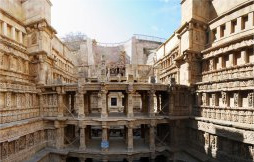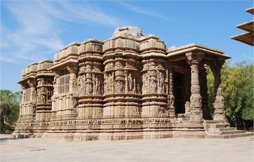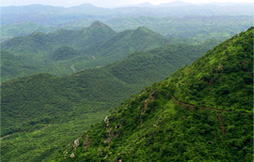THINGS TO DO IN NORTH GUJARAT
Rani Ki Vav
Rani ki vav is a famous stepwell situated in Patan town in Gujarat in India. It was probably completed by Udayamati and Karandev I after his death. This magnificent east facing step well measures approximately 64m long, 20m wide & 27m deep. A stepped corridor compartmented at regular intervals with pillared multi-storeyed pavilions is a unique feature. It was one of the largest and the most sumptuous structures of its type. It became silted up and much of it is not visible now, except for some rows of sculptured panels in the circular part of the well.
Among its ruins one pillar still stands which is the proof not only of the elegance of its design, but also excellent example of this period. The minute and exquisite carving of this vav is one of the finest specimens of its kind. Befitting its name, the Rani-Ki-Vav is now considered to be the queen among step wells of India. There is also a small Gate below the last step of the step well which has a 30 kilometre tunnel built which leads to the town of Sidhpur near Patan. It was used as an escape gateway for king who built the step well in the times of defeat.
Sun Temple
The Sun Temple, Modhera, at Modhera in Gujarat, is a temple dedicated to the Hindu Sun-God, Surya. It was built in 1026 AD by King Bhimdev of the Solanki dynasty. This temple depicts the essence of ancient times. The sculptures and architecture present in this temple are still magnificent after all these years. In the present times, prayers are not offered in this temple.
The Sun Temple was built by Rushabh Bhimdev I of Solanki Dynasty in AD 1026. This was the time when Somnath and the adjoining area was plundered by Mahmud Ghazni and reeled under the effects of his invasion. The Solankis, however, regained much of their lost power and splendour. Anahilvad Patan, the Solanki capital, was restored to glory. Royalty and traders jointly contributed to build grand temples. Solankis were considered to be Suryavanshi, Gurjar or descendants of Sun god. The temple was so designed that the first rays of the sun fell on the image of Surya, the Sun God, at the time equinoxes.
Kutch
Kutch literally means something which intermittently becomes wet and dry; a large part of this district is known as Rann of Kutch which is shallow wetland which submerges in water during the rainy season and becomes dry during other seasons. A carnival of colours, music and dance – the Rann Utsav – bedecks this arid land of Kutch at its best. During the festival time, the Tourism Corporation of Gujarat Ltd., (TCGL) organizes various activities for the tourists such as Rann
Safari, Kutch Carnival, cultural programmes, optional tours,
visit to a Kutchi village and adventure sports. The multihued fairs arranged by the banks of the lake or at the beach are another attraction of the festival.
The region has a great history of foreign trade in handicrafts with various countries. Even today the artifacts of Kutch have great demand in the national and international markets. Ethnic style embroidery, hand block painting, wood carving, silver work, pen-knives and nut crackers and sea shell toys and it goes on.
Ambaji
Ambaji mata temple is a major Shakti Peeth of India. It is situated at a distance of approximately 165 kilometres from Himmatnagar. A large number of devotees visit the temple every year specially on Purnima days. A large mela on Bhadarvi poornima (full moon day) is held. Every Year from all over the country people come here walking all over from their native place just to worship MAA AMBE in september.The whole Ambaji is lighted up as the whole nation lights up at the festive time of Diwali.
Just 5 km away from Ambaji Temple, The famous mountain of Gabbar is situated on the border of States of Gujarat and Rajasthan, near the flow of the origin of the famous Vedic virgin river SARASWATI, on the hills of Arasur in forest, towards south-west side to ancient hills of Arvalli
Shamlaji
The Shamlaji Temple stands in honour of Lord Vishnu. The magnificence of the temple is enhanced by stone carvings, idols of gods, nymphs, musicians and celestial dancers, domed ceilings, and a towering spire. Scenes from the epic stories Mahabharata and Ramayana grace the walls of this 11th-century temple. It’s one of the largest pilgrim temples of the Sabarkantha district in India. It is more commonly known among locals as Dhodi Dhwaja Wada, because it always has a white silk flag fluttering on top. Its unique designs on the outer part are one of its greatest attractions. The temple has a sculpture of Lord Krishna as Shamdiya bhagwan, with a piece of real diamond embossed on his chin.
Mount Abu (Rajasthan)
Mount Abu is a popular hill station in the Aravalli Range in Sirohi district of Rajasthan state in western India near the border with Gujarat. It's the only hill station in Rajasthan which has been a popular retreat from the heat of Rajasthan and neighboring Gujarat for centuries. The mountain is also home to several Hindu temples, including the Adhar Devi Temple carved out of solid rock; the Shri Raghunathji Temple; and a shrine and temple to Dattatreya built atop the Guru Shikhar peak.The oldest of these is the Vimal Vasahi temple, built in 1021 AD by Vimal Shah and dedicated to the first of the Jain Tirthankaras and they include the Achaleswar Mahadev Temple (1412) and the Kantinath Temple (1513). It is also the location of the headquarters of the Brahma Kumaris.









